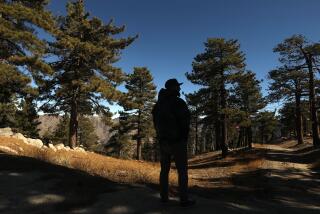Project Clouds Park Plans : Housing in Way of Mountains Recreation Area Wins OK
A state agency Friday approved the construction of houses on an expanse of oak-sprinkled hillside and meadow in Calabasas that the federal government wants to buy for the Santa Monica Mountains National Recreation Area.
The California Coastal Commission, meeting in Oakland, voted 10 to 1 to approve a scaled-down version of a plan by Quaker Corp. to subdivide its 272-acre tract on Mulholland Highway about one-half mile east of Las Virgenes Road in the Las Virgenes Valley.
The National Park Service hopes to buy the Quaker Corp. property and a neighboring 214-acre tract and open them for camping, picnicking and outdoor education programs. Agency officials say that the rugged mountain scenery and an abundance of flatland make the properties especially suitable for such uses.
But the Coastal Commission’s approval of the 34-unit subdivision means that time may be running out on the Park Service.
Months ago it exhausted its 1985 budget for buying land for the recreation area. A bill has passed the House that includes $12 million for the mountain park. But a Senate version contains no land acquisition money for fiscal 1986. A conference committee next month will try to arrive at a single version of the bills.
If the subdivision is developed, “I think we’d have to take some serious looks at how to readjust . . . some of our goals and aspirations” for the Las Virgenes Valley, said Nancy Ehorn, assistant superintendent of the recreation area.
‘Ambiance Could Change’
“The ambiance and the overall usability of that area for a lot of visitors could change if there are 34 houses right next to it,” she said.
“You realize what this means,” said David M. Brown of Calabasas, a member of two state parks advisory committees and an avid supporter of the national recreation area. “We are now cutting bone, not fat, on this park.”
According to Brown the Las Virgenes Valley, “including this property . . . is the recreational heart of the park. This is where people can picnic and camp in a beautiful mountain setting.”
Quaker Corp. president Leonard M. Ross, a Los Angeles attorney and businessman, could not be reached for comment.
‘Significant’ Improvement
Coastal Commission officials said they had little choice but to approve the proposal, which was improved in what one of them termed “very significant ways” from a previous plan the panel rejected in 1983. Moreover, the agency “cannot deny a project pending public acquisition unless acquisition is an immediate prospect,” according to a report by commission staff.
Commission member Marshall Grossman said approval of the subdivision would not foreclose federal acquisition. “It might cost them more money,” he said, “but, if it’s a project that is otherwise developable, then so be it.”
Quaker Corp. had sought approval for 49 homes, but the commission approved only 34. Previously, Los Angeles County had approved 46 lots on the tract.
Under conditions attached to the commission approval, the permit won’t be issued until revised plans are filed reflecting the lower density. Before getting the permit, Quaker Corp. also must file detailed grading plans and must dedicate easements to assure access by hikers to trails on the land and to protect wildlife habitat along a stream crossing the property.
Because it could take weeks or months to meet these conditions, Ehorn said, Park Service officials probably will know before development starts if they are going to have money to buy more land during the coming year.
Uncertainty Over Value
Yet it is uncertain how much money would be needed, given the vast difference between what the Park Service and Ross think the property is worth.
In 1983, the Park Service offered $1.7 million for the tract based on a contract appraisal. Ross rejected the offer and commissioned his own appraisal, which put the value of the tract at more than $10 million. Ross last year was able to get a bill through the Legislature selling the parcel to the state for $9 million. But the acquisition was deleted from the state budget by Gov. George Deukmejian.
‘Intent’ Reaffirmed
Although saying that Friday’s commission approval doesn’t alter the Park Service’s “intent and our interest in that property for public use,” Ehorn said she does not know if the Park Service would initiate eminent domain proceedings to head off development. She also said she does not know if the agency legally could take such a step if there is no money in the budget for the property being condemned.
Established in 1978, the national recreation area encompasses 150,000 acres of public and privately owned land extending from Griffith Park in Los Angeles to Point Mugu State Park in Ventura County. Under current plans, about two-thirds of the recreation area eventually will be owned by federal, state or local parks agencies. The other one-third would remain in private hands, although some uses would be restricted by easements.
Plans call for the federal government to own 36,000 acres within the recreation area. So far, the Park Service has spent about $65 million to acquire 10,800 acres.
More to Read
Sign up for Essential California
The most important California stories and recommendations in your inbox every morning.
You may occasionally receive promotional content from the Los Angeles Times.










